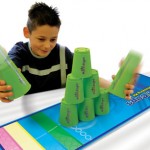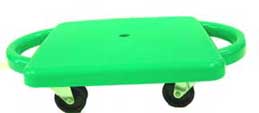Equality (Straddle) Ball Setup:
- One soft small foam ball or playground ball for a group of five to eight students.
- The group sets up in a circle with legs wide apart and feet touching.
- The space between each player’s feet is a goal that they defend by using their hands only.
- Bend your knees and get low with the palms of your hands facing the middle of the circle and your fingers pointing down.
- Ready, Begin…
The game starts when one player sets the ball in front of them and taps it with their hand in an attempt to get the ball through another player’s legs.
- The ball may only be tapped with their hands. No stopping the ball and rolling it.
- You may not reach over in front of another player’s “goal”.
- If a ball travels outside of the circle, the player that touched it last should retrieve it and start a new game.
Variation One: Use two or even three balls if it is a larger group.
Variation Two (Doggy Style): Turn around so you are facing out. Position your feet, so you have to hit the ball through your legs backwards.



